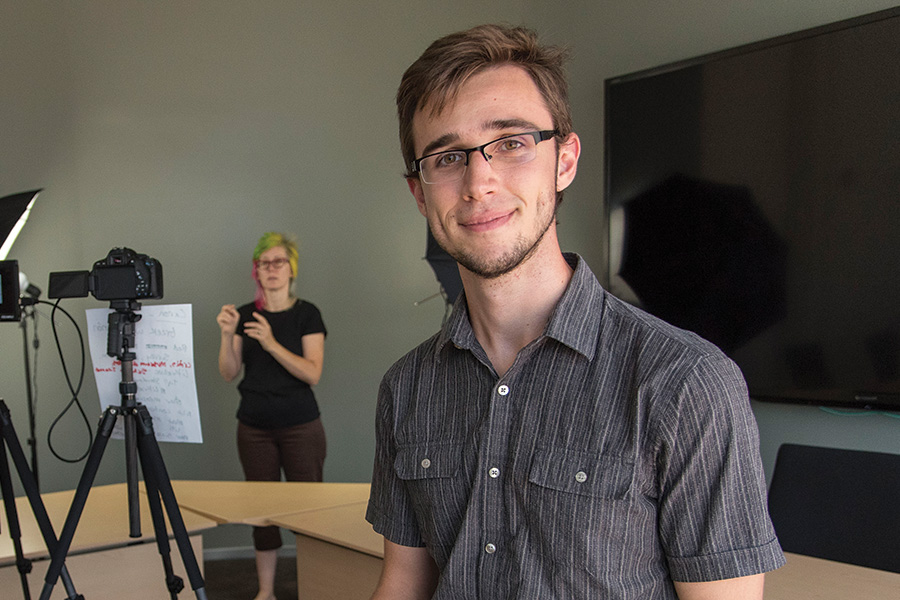LEARNING BY DOING
Sign Me Up!
Kai Pepler '18 applies his design skills in an internship with global implications for the Deaf community
by Joanie Eppinga

Kai Pepler '18, a visual communication design major, interned at the National Technical Institute for the Deaf, seeking ways to better communicate new ASL signs to the public.
Think of working on a project whose benefit will span the globe. Then, imagine doing it while you’re still a junior in college.
That’s the reality for Kai Pepler '18, a visual communication design major. “This is an incredible opportunity,” Pepler says, referring to his interdisciplinary internship at the National Technical Institute for the Deaf (NTID) at Rochester Institute of Technology (RIT). “I love this project!”
“This project” is the invention, recording, and distribution of new American Sign Language (ASL) signs for the field of philosophy. Representations are needed because interpreters struggle to translate complex philosophical concepts. Furthermore, like spoken English, ASL is a dynamic language that continually incorporates new words. “Certain concepts have no official sign in ASL,” notes Miriam Lerner, an interpreter at NTID. “Therefore it takes a lot of time to explain them; it’s not just one sign doing the work.”
After NTID got a grant from Congress, a team decided to document new signs—and that’s where Pepler comes in. He takes video of the sign masters demonstrating each sign, which he then edits and puts on the website he’s created, adding text translations and links to additional resources.
“My dream career is to work in visual design in education,” Pepler says. “I can’t think of a better building block than this internship. I’ve had so many terrific classes on illustration, writing, video work, sound, web design—and on this project I get to use all of them.”
Lerner, as Pepler’s NTID supervisor, appreciates the breadth of Pepler’s knowledge. “Kai came from Nazareth with this amazing facility to negotiate what we need with what he knows,” she says. “Hours after we discuss something, he comes back with, ‘I figured out how to do it’.”
In addition to having technical acumen, Pepler grew up with sign language—his parents are interpreters. Pepler says he’s conversational rather than fluent, but he’s learning more all the time as he uses ASL to communicate with people on the project. “It’s a challenge,” Pepler says, “but it’s the best kind, because it allows me to explore a new way of thinking.”
New fields are also likely to be explored as the project grows: the team hopes to branch out into literature, STEM, art, and beyond. NTID will publicize the project by posting on social media and linking to a previous version of the website that has received tens of thousands of hits. Lerner notes that the group will also present the site at academic conferences and interpreter gatherings. Finally, the site will be moved to RIT servers, where it will be accessible, at no cost, to everyone, everywhere.
Pepler says, “I’m awed by what it could mean if this work becomes integrated into the world.” Hamilton says she too appreciates the scope of the project, adding, “Kai’s experience is a shining example of what we hope for all our students at Naz: that their learning will be enriched through meaningful work that has tremendous impact on a community larger than themselves.”
Pepler thoroughly enjoys helping to contribute to the flow of a global language. “I’m working to present it in the most effective and beautiful way possible,” Pepler says. “Then it’s up to the world to work with it.”
Post-graduation update: Pepler was hired as a web designer and videographer at RIT's National Technical Institute for the Deaf. His role evolved to videographer/visual communication designer.
Joanie Eppinga is a freelance writer and editor in Spokane, Washington.